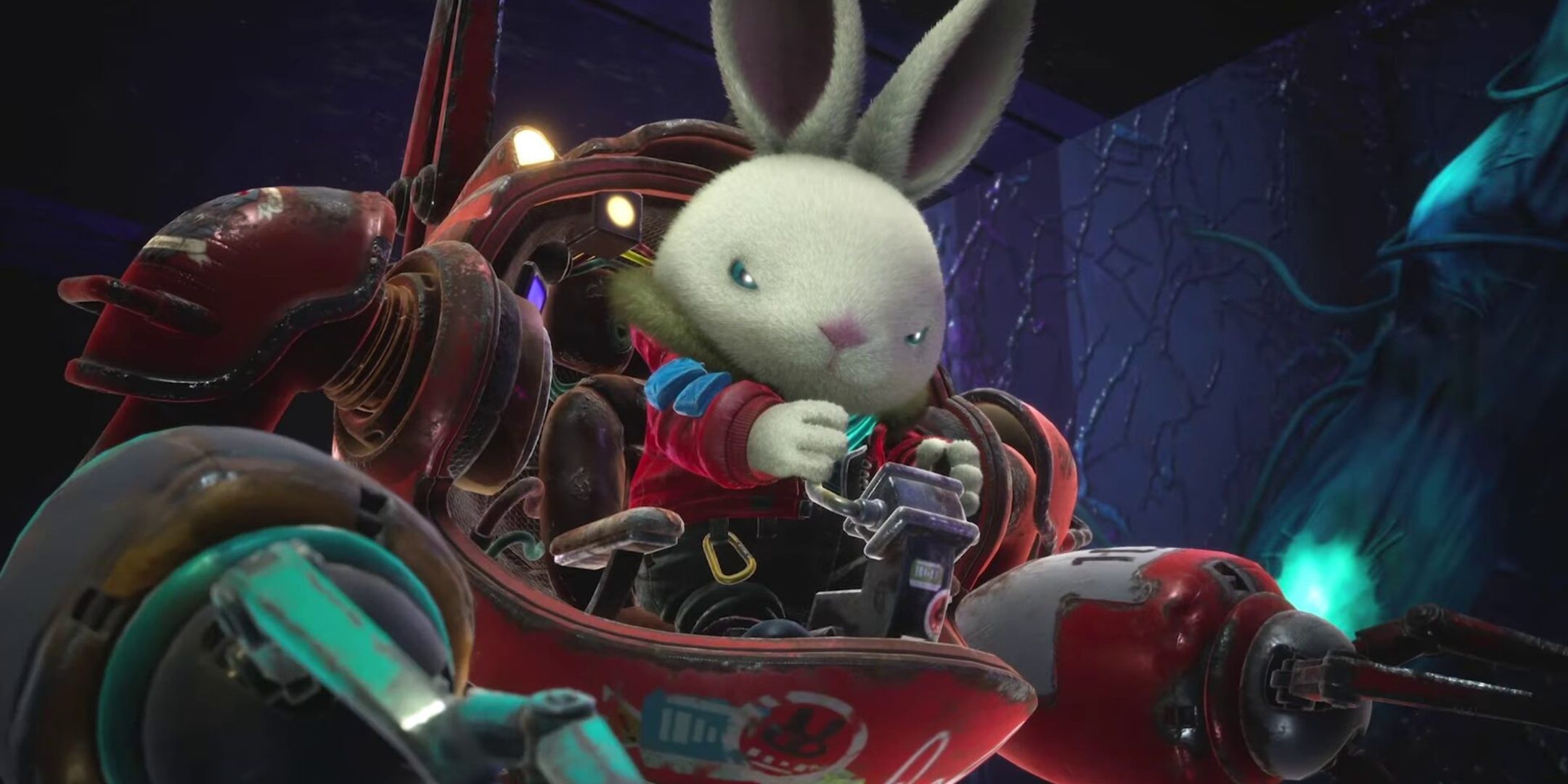Gen Urobuchi Interview: Rusty Rabbit, Madoka Magica, And The Impact Of His Legacy

Rusty Rabbit is one of the last things I expected to see from Gen Urobuchi, a creative whose past projects include iconic yet controversial visual novels like Sayo No Uta or gorgeous and subversive anime such as Psycho-Pass and Madoka Magica. Anything this man touches has been watched with curious eyes, so we had to catch up with him about Rusty Rabbit.
Following a grumpy albeit cuddly rabbit who has spent his years mining for resources within a post-apocalyptic world, this little critter brought to life by Takaya Kuroda possesses a heart of gold that slowly but surely rises to the surface throughout the course of the campaign. We break down Rusty Rabbit and other milestones of Urobuchi’s career, so let’s get right into it.
Rusty Rabbit Is More Than Meets The Eye, Says Gen Urobuchi
TheGamer: I read that one of the core pieces of inspiration for Rusty Rabbit was an image of a Sylvanian Families doll outfitted in a mech? Why did this resonate so much with you?
Gen Urobuchi: I spent my youth in the 20th century, and I feel an irresistible sense of nostalgia for rusted machines. The world existed outside the LCD screens, and everything was something you could touch with your hands. The combination of stuffed animals and rusty iron stirs memories of that time in a very personal way.
TG: How was it to pursue Rusty Rabbit as a passion project during the pandemic? I have seen so many distinct creative ideas emerge from that period, do you think it had an impact on how you approached things?
GU: There was a period when I was completely absorbed in the hobby of creating games solo using Unity. The fulfillment of building a world through language—whether through scenario writing or C# programming—felt very much the same. Even in an enclosed, isolated environment, I realized that joy could still be found in abundance.
TG: Rusty Rabbit is utterly adorable and somewhat absurd as a concept, but like much of your past work, are there darker themes and narrative elements waiting for players to uncover?
GU: I believe the personality of the protagonist is deeply influenced by the memory of my father, who passed away during the COVID-19 pandemic. I made a conscious effort to steer the tone of the story toward something light-hearted and comical, so that these personal circumstances wouldn’t cast an overly gloomy shadow on the work.
TG: How exactly did the world come to an end in Rusty Rabbit, and what led to rabbits becoming the dominant species on Earth and learning the ways of human speech?
GU: It ties into a major plot twist in the story, so I can’t go into detail here, but to put it simply—as the main visual plainly suggests—“It’s too cold,” and “fluffiness is justice.” That’s the whole reason behind it.
[Takaya Kuroda] fully understood the challenging role of an aging rabbit—a character that combines gravitas with charm—and portrayed him masterfully. From the very first line in the recording studio, I felt it immediately: Stamp was there.
TG: You have prior experience with video games in the visual novel genre and others, but how did it feel to shift your talents to a Metroidvania experience like this one?
GU: More than anything, the fact that this was a project I initiated myself is what makes it so meaningful to me. The catalyst was encountering Unity—a convenient tool that made this possible. My affection for the types of games I loved most as a child took form in this work.
TG: The main character is played by Takaya Kuroda, who most players will know as Kazuma Kiryu in the Like A Dragon series. How was it to place such a gruff and masculine voice onto this cute and cuddly character?
GU: The casting was handled by producer Yuichiro Saito. Initially, I was personally concerned that the image of Kazuma Kiryu might be too overpowering, but Mr. Takaya Kuroda truly demonstrated the depth of his talent as a voice actor. He fully understood the challenging role of an aging rabbit—a character that combines gravitas with charm—and portrayed him masterfully. From the very first line in the recording studio, I felt it immediately: Stamp was there.
TG: In the past, when writing characters, you have said you like to give them one trait or characteristic shared by yourself so you can feel a connection to them. I would love to learn what this is in the case of Rusty Rabbit?
GU: This is purely my personal impression, but I feel as though the world I was most familiar with has gradually disappeared. It may be presumptuous to speak like an old man when I’m only in my 50s, but changes in the cityscape due to redevelopment, and the shifting currents of culture, constantly remind me that I now belong to the past. Those feelings, I believe, have been entrusted to the characters in this story.
Gen Urubochi On Visual Novels, Saya No Uta, And Madoka Magica
TG: The combination of an outwardly adorable aesthetic and darker subject matter also reminded me of your work on Madoka Magica and Saya No Uta. Do you feel these three share a spiritual connection in some way?
GU: I tend to become completely absorbed in whatever project I’m currently working on, to the point that I lose sight of everything else. Because of that, I don’t really feel any sense of continuity between my past works. When I’m focused on a new piece, I forget the previous ones entirely. As a result, I sometimes end up inadvertently reusing the same ideas.
TG: Speaking of Saya No Uta, it was once described by a Western critic as “one of the most messed-up games ever made” but I’ve always found parts of it to be strangely beautiful. How do you feel about the experience of making it all these years later?
GU: Looking back, that particular work was created during a time when I was still young and very much a rebellious spirit—perhaps even at the height of my tendency to push boundaries for the sake of provocation.
I recall feeling a bit uneasy during the debugging phase, thinking to myself, "Maybe I've gone too far with the dark humor this time." However, after the game was released and the reactions came in, I was struck by how effortlessly players accepted and digested what I had thought might be excessive. Their resilience truly encouraged me.
TG: Building on my previous question, how do you feel the visual novel genre has come to evolve in recent years? It seems to have shifted and changed so much in the past decade alone.
GU: Reading text on an LCD screen rather than on paper has become completely natural today, and with that, I feel the sense of innovation that once surrounded visual novels has faded. I believe the medium is now at a point where a new leap forward is possible. Even in Rusty Rabbit, I believe there are strong traces of visual novel DNA throughout.
“The characters I’ve written have always found their own answers within themselves by the end of their journeys. I’ve never really written stories where heroes devote themselves entirely to divine faith, noble ideals, or the values of their community.”
TG: I’d also love to ask about your reflection on Madoka Magica, as in several ways it helped to both revitalise and showcase exactly what the Mahou Shoujo genre was capable of when taken outside of its comfort zone. How do you feel about both the series and trio of movies that followed them?
GU: To be honest, the core idea itself isn’t all that unusual. If we had brought that story to life through Nitroplus’s usual production pipeline, I doubt it would’ve stood out in any meaningful way. I think it blossomed into something special thanks to Ume Aoki’s charming character designs and SHAFT’s exceptional direction. That synergy truly transformed the project.
TG: This is somewhat of a self-indulgent question, but over the years, a lot of fans have come to interpret the relationship between Madoka and Homura as romantic and familial. I’d love to hear your take on it as the writer behind them?
GU: I’ve often heard that adolescent girls can sometimes form extremely intense emotional attachments to others. It makes me wonder if such weighty relationships exist more commonly than we think among young girls. Then again, that might just be the misguided assumption of a man in his 50s.
TG: Looking back on your career as a writer, what would you describe as one of the most defining features of your work that can be found across the majority of stories you tell and characters you create?
GU: Reflecting on my body of work, I think the characters I’ve written have always found their own answers within themselves by the end of their journeys. I’ve never really written stories where heroes devote themselves entirely to divine faith, noble ideals, or the values of their community. That kind of figure doesn’t seem to exist in my drawer.
Rusty Rabbit is the sort of experience I’d expect to be penned by Gen Urobuchi, yet also nothing like he’s ever done before, and that alone makes it worth checking out if you’re a fan of his work. It’s available now on PS5, Xbox, Nintendo Switch, and PC.
6 Images 6 Images CloseYour Rating
close 10 stars 9 stars 8 stars 7 stars 6 stars 5 stars 4 stars 3 stars 2 stars 1 star Rate Now 0/10Your comment has not been saved
Like Follow FollowedRusty Rabbit
Platformer Metroidvania Action Adventure Side-scroller Systems OpenCritic Reviews Top Critic Avg: 69/100 Critics Rec: 46% Released April 17, 2025 ESRB Everyone // Mild Fantasy Violence Developer(s) Nitroplus Publisher(s) NetEase Games, SoFunWHERE TO PLAY
DIGITAL












